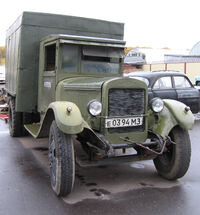The ZIS-5 (Russian: ЗиС-5) was a 4x2 Soviet truck produced by Moscow ZiS factory from October 1933 on. It was an almost identical copy of the American Autocar Model CA truck.
Development[]
In 1931 Moscow Avtomobilnoe Moskovskoe Obshchestvo (AMO, Russian Автомобильное Московское Общество (АМО) — Moscow Automotive Enterprise) truck plant was re-equipped and expanded with the help of the American A.J. Brandt Co., and began to produce a new truck with designation of AMO-2. AMO-2 was intended as a replacement of the previous AMO-F15, the first Soviet truck ever built (it was a copy of the Italian Fiat F-15).
Soon AMO-2 was improved, and new models AMO-3 and AMO-4 appeared. In 1933 AMO was rebuilt again and renamed into Factory No. 2 Zavod Imeni Stalina (or Plant of Stalin's Name, abbreviated in ZIS or ZiS) and in Summer first prototypes of the new ZIS-5 appeared.
Production[]

A ZIS-5 used for transporting bread.
Serial production of the new truck started on October 1, 1933. The truck was an instant success and, which together with GAZ AA, became the main Soviet truck of 1930-50's. It also evolved into the workhorse of the Soviet armed forces: at the beginning of Operation Barbarossa the Red Army could line up 104,200 of those trucks.
Facing the German invasion, in the autumn of 1941 the production line at Moscow plant was stopped and ZIS was moved to Ulianovsk (on the Volga river) and to Miass (in the Chelyabinsk region of the Urals). Production at Ulianovsk UASZIS lasted from February 1942 to 1944, while UralZIS at Ulianovsk it began in July 1944; UralZIS fitted the truck radiators with own label and produced it until 1955, well after the end of the war.
In the meantime Moscow ZIS plant had restarted production of these trucks in April 1942, and continued until 1948, when the new ZIS-50 (ZIS-5 with new engine) appeared.
In 1955 UralZIS also modified the ZIS-5: It got new engine and oval fenders, different from pre-war ones. This new model received the designation of UralZIS-355 or ZIS-355.
The ZIS-5V[]

ZIS-5V
At the end of 1941 war shortages of raw materials forced to change the construction of ZIS-5. All changes were focused on simplify construction: the round, stamped wings were replaced with flat, bended ones, cabs and foot boards were now made from wood, brakes were removed from front wheels, rear body had the tailgate swinging only. Sometimes also the right headlight was removed, while bumpers disappeared forever.
The simplified model, designated ZIS-5V, was produced since May 1942 in Ulyanovsk, and later also in Moscow and Miass. Overall production scored about 1 million units (all plants), with ZIS alone producing 532,311 samples. During the War years were produced about 83.000 of ZIS-5 of both versions.
Utilization[]
During the war the ZIS-5 was used on all fronts, where it was greatly appreciated for its remarkably simple and reliable construction. Apart for cargo duties, the ZIS-5 was used as a light artillery tractor and for troops transportation (25 soldiers could seat in five benches placed in the rear body). ZIS-5 served also as base for many special trucks, like refuellers, field workshops, ambulances, portee guns or AA platforms.
After the GAZ-AA, the ZIS-5 was the 2nd most used Red Army truck of 1933-1943 period. The intensive growth of Lend Lease trucks shipping in 1943-1944 did not affected the first line use of the "Tryohtonka" (as soldiers called the ZIS-5 for its 3-ton payload), while GAZ-AA got somewhat phased out to secondary roles.
The ZIS-5 showed remarkable service on the "Road of Life", the only supply line to the besieged city of Leningrad, opened on the frozen surface of the Ladoga Lake in the winter months during 1941–1944.
Export[]
ZIS-5 was the first Soviet motor vehicle to be exported. A batch of 100 trucks were sold to Turkey in 1934; other quantities were subsequently purchased by Afghanistan, Iraq, Iran, Spain, China, Latvia, Lithuania, Ethonia, Mongolia and Romania. Some trophy vehicles were used by Finns who had captured them during the Winter War of 1939-40, and by Germans after the invasion of Soviet Union of June 1941.
Specification[]
- 4x2, 2-axle 3-ton cargo truck
- Overall production: about 1 million
- Engine: carburettor, 73 hp(*)/2300rpm 6-cyl. SV, 5557 cc, watercooled (from Jan. 1944 - 76 hp/2400rpm, from early 1950s - 85 hp)
- Bore/Stroke: 101,6/114,3 mm
- Length: 6,060 mm (238.6 in) (with bumper)
- Height: 2,160 mm (85.0 in)
- Width: 2,235 mm (88.0 in)
- Wheelbase: 3,810 mm (150.0 in)
- Transmission: 4x2 speed without synchronizers
- Weight: 3,100 kg (6,834 lb) (unloaded)
- Maximal speed: 60 km/h (37 mph) (from early 1950s - 70 km/h (43 mph))
- Tyres: 34x7 or 9,00x20 (post-war) inches, admittable change for 36x8.
- Fuel consumption: 34.0 L/100 km
(*) People who investigated ZIS-5 told that real power of engine was less than proclaimed in official documents and equal to 67-68 hp.
See also[]
- Katyusha rocket launcher
- ZIS-6
External links[]
- Henkofholland [1]
- Autogallery [2]
- ZiS-5 at website Engines of the Red Army in WW2 [3]
- ZiS-5V at website Engines of the Red Army in WW2 [4]
| This page uses some content from Wikipedia. The original article was at ZiS-5. The list of authors can be seen in the page history. As with Tractor & Construction Plant Wiki, the text of Wikipedia is available under the Creative Commons by Attribution License and/or GNU Free Documentation License. Please check page history for when the original article was copied to Wikia |